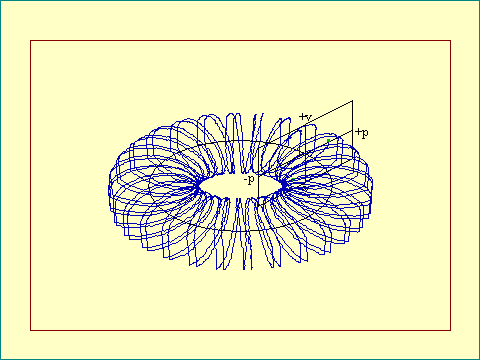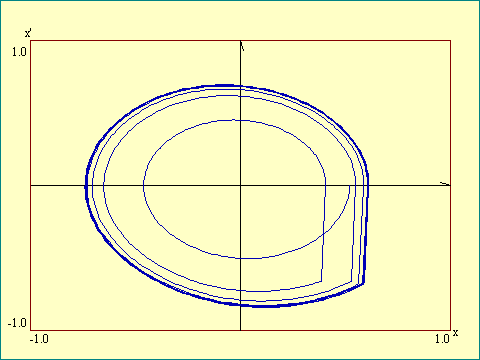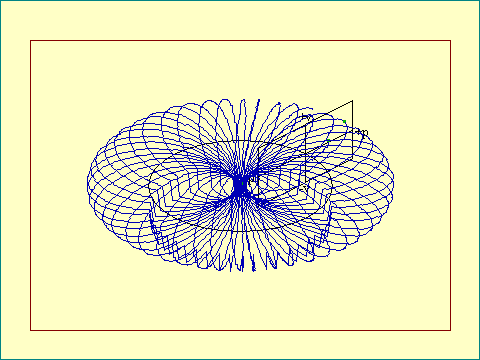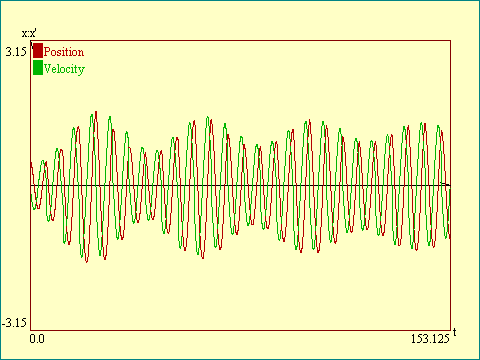|
|
|
|
Here's the kicker...
|
Now suppose that there is a mechanism to put energy into our
dynamical system in order to make up for the losses. This is
getting a lot closer to physical reality. In fact the pendulum in
an ordinary grandfather's clock is exactly this arrangement.
What would the phase space orbit of such a pendulum look like? To
begin with let's look at a system with rather a large amount
of loss such that in a single cycle the amplitude drops
noticeably. Then assume we add energy equal to this loss in a
single kick at the cycle's end. Run the
Pendulum Driven by Kick at Peak of Swing
display.
In real clockwork mechanisms the energy loss is small so that
the decrease in amplitude in a single cycle is practically
undetectable. Therefore the energy required to make it up is
small and noticeable transients are avoided. It appears as though
energy was being both lost and added on a continuous basis. In a
driven pendulum, the amount of energy delivered during a cycle is
approximately constant. The amount of energy lost per cycle
depends on the amplitude of that cycle.
If we disturb our driven pendulum, bumping it up into a larger
amplitude, losses will exceed additions and the pendulum will
lose energy, causing the amplitude to decrease. If we disturb it
by absorbing some energy from it knocking it into a small
amplitude, the energy additions will exceed the losses and the
amplitude will increase. Any large swings will tend to get
smaller, any small swings will tend to get larger. Because of
this, the driven pendulum, with losses, settles down to an
attractor as did the undriven pendulum with losses. The
difference is in the nature of the attractor.
|

|

|
The attractor for the undriven lossy pendulum was a point in
phase space called an "equilibrium point" or
"point attractor". The attractor for a driven, lossy
pendulum is a closed path, in this case the phase space projection
view is an elliptical figure with a ding in it where the kick comes in.
This sort of attractor is called a "limit
cycle" or "periodic attractor".
If any external disturbance interferes with the operation of
the undriven pendulum without losses it could easily be knocked
into a different orbit either larger or smaller than the
original. If the driven, lossy pendulum is disturbed it will tend
to settle back to its original orbit after the transient
associated with the disturbance dies away. The attractor in phase
space of the driven, lossy pendulum is said to be stable.
|
|
Now let's look in a little more detail at the process of
delivering energy to our driven pendulum. This gets right at the
heart of how we model dynamical systems mathematically. Remember
in the
Dynamical System Background text
we discussed the modeling process and numerical
integration of the differential equations controlling the state
variables. One of the points covered was the discontinuous nature
of model time as compared to the apparently continuous nature of
real time. Time in the model lurches along in little delta t
increments I called chronons. One of the implications of the
discontinuous nature of model time is that any applied force must
be applied for at least a single chronon. Of course it could be
applied for more time than that, but not less. So basically the
kick we give the pendulum at the end of its cycle is an applied
force of fixed magnitude and one chronon duration. The amount of
energy delivered during such a kick is the magnitude of the
force, times the distance through which the pendulum moved while
the force was being applied. This follows (at some distance) from
Newton's laws of motion. See the
Physics 1 - Mechanics
program for more on this.
 So if I apply a force
of fixed magnitude for a time of one chronon, when the pendulum
is moving slowly, like at the end of a cycle, the distance
covered will be rather small and the energy imparted likewise
moderate. If I apply the same force for the same duration when
the pendulum is moving fast, like at the bottom of a swing, more
energy should be delivered. Run the
Pendulum, Driven by Kick at Bottom of Swing display to see
this effect. The amazing thing is that this distinction falls out automatically
from the mathematical model. There is no need to write code to instruct the
computer on how to adjust the energy.
So if I apply a force
of fixed magnitude for a time of one chronon, when the pendulum
is moving slowly, like at the end of a cycle, the distance
covered will be rather small and the energy imparted likewise
moderate. If I apply the same force for the same duration when
the pendulum is moving fast, like at the bottom of a swing, more
energy should be delivered. Run the
Pendulum, Driven by Kick at Bottom of Swing display to see
this effect. The amazing thing is that this distinction falls out automatically
from the mathematical model. There is no need to write code to instruct the
computer on how to adjust the energy.
|

|

|
Remember back at the beginning of this section we said that
the solution to the differential equation describing a pendulum
meeting our conditions was p=A*sin(t) ,
where p represented the pendulum position, measured as an angle
from vertical. It is evident from this equation that the period
of a cycle is independent of the amplitude A, since A does not
appear anywhere in the argument of the sine function (the stuff
in the parentheses following sin). If the equation holds true
then a kick at a regular interval should occur at the same place
in a cycle, even if the kick by adding energy changes the
amplitude.
Run the Pendulum Driven by Kick at
Fixed Interval display.
Finally run the
Pendulum, Driven, With User Start
display to play around with swings of any amplitude.
We have made extensive use of the pendulum model to introduce
some of the concepts of dynamical system studies. In the next
lesson we will look at another dynamical system with a more
complex response than the pendulum. The next lesson is called
Periodic Attractors.

Are there any questions?
|

 Next
Next
 Previous
Previous
 Other
Other
|
|
|
|




